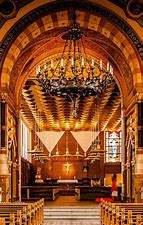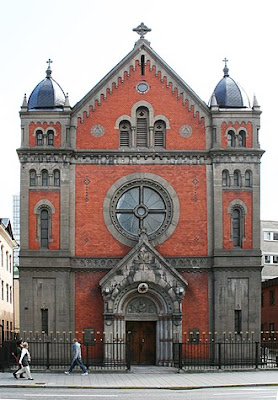Other Nations—6
Scandinavia
This blog is the sixth of six to discuss nations that do not have ecclesiastic provinces. Typically the jurisdictions are subject directly to the pope. This blog covers Scandinavia—Denmark (including Greenland and the Faroe Islands), Finland (including the Aland Islands), Iceland, Norway (including Svalbard and Jan Mayen), and Sweden.
Denmark
Denmark became a kingdom by the late 8th Century and for the next two centuries, Danish Vikings raided and settled parts of England and Western Europe. St. Ansgar brought Catholicism to Denmark in the 9th Century and he established a diocese in 831. Harald Bluetooth, the King of Denmark, declared his nation to be Catholic around 965, and by 1060, there were six Catholic dioceses. This changed in 1536 when the nation embraced Lutheranism. Catholicism was outlawed until 1682, but even then, conversion from Lutheranism was illegal. Full religious rights for Catholics, and others, was not allowed until 1849.
The Faroe Islands, which are part of Denmark, were settled by Vikings in the 9th Century and have been part of Denmark since the 14th Century. A Catholic diocese was established there in 1076. Greenland, which is the world’s largest island, is also part of Denmark. The Vikings came to Greenland in the 10th Century from Iceland and Danish colonization began in the 18th Century. Greenland became part of Denmark in 1953. Catholic missionaries came to Greenland at the beginning of the 11th Century and established churches—the first known churches in the Western Hemisphere. A diocese was established in 1124 at Gardar in southern Greenland, near modern day Igaliku. Both the Faroe Islands and Greenland embraced Lutheranism in the 1530s.
Denmark has 5.9 million people, including 58,000 in Greenland and 51,000 in the Faroe Islands. About 75 percent of Denmark’s people belong to the official Evangelical Lutheran Church and 6 percent are Muslim. Lutherans account for at least 90 percent of the people in Greenland and the Faroe Islands. Denmark’s 48,000 Catholics are part of the Diocese of Copenhagen, which is immediately subject to the Pope. This began as the Apostolic Vicariate of Northern Missions in 1868 before being demoted to the Apostolic Prefecture of Denmark in 1869. It once again became an apostolic vicariate in 1892 before becoming the Diocese of Copenhagen in 1953. St. Ansgar’s Cathedral in Copenhagen was built between 1840 and 1842. At the time of its construction, it was the only Catholic church in Denmark and served mostly foreign diplomats and their families. The Cathedral contains a relic of St. Lucius, a Third Century pope.
The first picture is from Flickr, the next two from Panaramio, the fourth is from Pinterest, and the last from Wikipedia.
Ukrainian-rite Catholics in Denmark are served by the Apostolic Exarchate of Germany and Scandinavia headquartered in Munich, Germany.
Finland
Finland was part of Sweden from the 12th to the 19th Centuries and became part of Russia in 1809. It finally gained independence in 1917. Catholicism came to Finland in the 11th Century, but almost all Finns became Lutheran after the 16th Century Protestant Reformation. It would not be until 1799 that a Catholic parish would be reestablished in Finland and 1929 that the Church would receive full legal status.
Finland, including the Aland Islands, has 5.6 million people and 70 percent are Lutheran. About 3 percent belong to another religious group and 27 percent have no specific religion. There are only 15,000 Catholics, about half of whom are immigrants or foreign nationals, who make up the Diocese of Helsinki. The Diocese was created in 1955 after first being established as an apostolic vicariate in 1920. It is immediately subject to the Pope. Catholic parishes in Finland celebrate Mass in 20 languages.
St. Henry’s Cathedral is in Helsinki and is dedicated to a 12th Century Finnish bishop. The Gothic Revival church was built between 1858 and 1860.
The first picture is from Pinterest and the rest are from Wikipedia.
Iceland
Iceland was settled by Norwegian and Celtic peoples starting in the 9th Century. It was eventually ruled by Norway and Denmark and did not achieve complete independence until 1944. Among the first settlers were Irish monks and around 1000, Iceland officially became a Catholic nation. Southern Iceland was served by the Diocese of Skalholt (now a village about 40 miles east of Reykjavik) established in 1056. Northern Iceland was served by the Diocese of Holar (now a village in north central Iceland), which was established in 1106. The Protestant Reformation came to Iceland in the mid-1500s, encourage by King Christian III of Denmark and Norway, who had converted to Lutheranism. The two Catholic bishops resisted the change and one was executed 1550 and the other exiled. Catholicism was outlawed and faithful Catholics were forced into exile. It would not be until the mid-1800s that Catholic missionaries were allowed into Iceland.
About two-thirds of Iceland’s 350,000 people belong to the official Evangelical Lutheran Church. Catholics account for 4 percent, other religions (mostly Protestant) account for 11 percent. The Church has grown rapidly in recent years mostly due to Eastern European and Filipino immigrants. The Catholics are served by the Diocese of Reykjavik, which was established as an apostolic prefecture in 1923, became an apostolic vicariate in 1929, and a diocese in 1968. It is immediately subject to the Pope. Christ the King Cathedral is in Reykjavik. The Neo-Gothic cathedral opened in 1929 and has a flat top rather than a steeple. Pope Pius XI gave the cathedral a statue of Christ standing on the world which is located above the main altar. The Stations of the Cross were painted in Bavaria a century ago. A wooden Madonna from the 14th Century is on the left side of the sanctuary. Pope John Paul II designated the cathedral as a minor basilica in 1999.
The first picture is from Flickr and the other two are from Pinterest.
Norway
Norwegian Vikings terrorized Europe for two centuries until King Olav converted to Catholicism in 994. Norway became a part of Denmark in 1397 and part of Sweden in 1814, before gaining independence in 1905. After King Olav, it took many years for English and Irish missionaries to complete the work of conversion in Norway. The Diocese of Nidaros (Trondheim) was established in 1015 and became a metropolitan archdiocese in 1152. The province consisted of four other Norwegian dioceses, as well as dioceses in the Faroe Islands, the Orkney and Shetland Islands, the Isle of Man, Iceland, and Greenland. The King of Denmark imposed Lutheranism on Norway in 1537, and despite persecution, Catholicism remained in various places until about 1700. Priests were exiled, imprisoned, or executed. It was not until 1843 that Norway allowed religious tolerance.
Norway’s 5.5 million people, including those living in the Svalbard and Jan Mayen islands mostly (71 percent) belong to the Evangelical Lutheran Church of Norway, which is the state church. Other Protestants account for 4 percent and Catholics and Muslims each account for 3 percent. About 17 percent profess no specific religion. Most Norwegian Catholics today are immigrants—mostly from Poland—but also from other European nations, Chile, the Philippines, and Vietnam.
Roman rite Catholics belong to one of three jurisdictions, all of which are immediately subject to the Pope:
- The Diocese of Oslo was established in 1070 and suppressed in 1537. It was restored as a Mission sui juris in 1868, became an apostolic prefecture in 1869, and apostolic vicariate in 1892, and once again a diocese in 1953. St. Olav’s Cathedral is in Oslo. St. Olav’s opened in 1856 and has masses in several languages, including Polish.
Both pictures are from Wikipedia.
- The Territorial Prelature of Tromso began as a Mission sui juris in 1931, became an apostolic prefecture in 1944, an apostolic vicariate in 1955, and a territorial prelature in 1979. The Cathedral of Our Lady is in Tromso. The Neo-Gothic wooden church was built in 1861 and seats 150. It is the northernmost Catholic cathedral in the world.
Pictures are from Panaramio, TripAdvisor, and Wikipedia.
- The Territorial Prelature of Trondheim was established as the Diocese of Nidaros in 1030 and became a metropolitan archdiocese in 1154. It was suppressed in 1537. It was restored as a Mission sui juris in 1931, became an apostolic prefecture in 1935, and apostolic vicariate in 1953, before becoming a territorial prelature in 1979. St. Olav’s Cathedral is in Trondheim. The brick cathedral opened in 2016 and has a separate clock tower with six bells.
Both picture are from Wikipedia.
Ukrainian-rite Catholics in Norway are served by the Apostolic Exarchate of Germany and Scandinavia headquartered in Munich, Germany.
Sweden
Swedish Vikings raided throughout the Baltic region and beyond from the 8th to the 11th Centuries. Sweden has been a kingdom at least since the 9th Century. Catholicism was brought to Sweden in 829 by St. Ansgar, although it would take until the 12th Century to be firmly established. The Diocese of Lund (which was then in Denmark) was established in 1060 and became a metropolitan archdiocese in 1104 and had several suffragan dioceses. The Metropolitan Archdiocese of Uppsala was created in 1164. The Protestant Reformation started in Sweden when King Gustav Vasa nationalized the Swedish church in 1527, although it would take until 1593 for Lutheranism to become the state church. For the next two centuries, Catholics in Sweden were either deported or killed. Conversion to Catholicism was not decriminalized until 1860 and not made fully legal until 1977.
About 60 percent of Sweden’s 10.2 million people belong to the Lutheran Church of Sweden. Another 9 percent, including 120,000 Catholics, belong to some other Faith tradition. Over 30 percent of Swedes have no specific religious beliefs, if any. Sweden’s Catholics are mostly immigrants (including people from Eastern Europe, the Middle East, and South America) and are served by the Diocese of Stockholm. This was established as an apostolic prefecture in 1781, became an apostolic vicariate in 1783, and a diocese in 1953. It is immediately subject to the Pope. The Diocese’s current bishop is a Cardinal. Ukrainian-rite Catholics in Sweden are served by the Apostolic Exarchate of Germany and Scandinavia headquartered in Munich, Germany. The cathedral for the Diocese of Stockholm is dedicated to St. Eric and is located in Stockholm. The Cathedral was built in 1892 and dedicated to a 12th Century Swedish king who was slain by a Danish prince.
The first picture is from Flickr, the second from Pinterest, and the rest from Wikipedia.
Definitions
The Catholic Church is mostly divided into ecclesiastical provinces—a province consists of a metropolitan archdiocese and one or more dioceses. The province and the archdiocese are led by an archbishop. Each of the dioceses is called a suffragan diocese and is led by a bishop. Archbishops have some responsibilities for the province, but all bishops answer directly to the Pope. There are also missionary territories below the level of a diocese, which include apostolic vicariates, apostolic prefectures, territorial prelatures, and missions sui juris.
Most Catholics in the world belong to the Latin or Roman rite. Rite refers to liturgical practices, ecclesiastical discipline, and spiritual heritage. Many Catholics belong to one of two dozen Eastern rite churches. Eastern rite churches trace their heritage to Eastern Europe and the Middle East. Eastern rite churches sometimes use different terminologies. For example, a diocese might be called an eparchy and is led by an eparch. A vicariate apostolic is called an exarchy and is led by an exarch.
A basilica is an honorary title bestowed on a church by the Pope because of the church’s antiquity, dignity, historical importance, or significance as a center of worship. Some cathedrals are also basilicas. Each basilica has a ceremonial umbrella in the papal colors of white and yellow and a ceremonial bell. Both of these are symbolic of the Pope’s special relationship to the basilica.




























No comments:
Post a Comment